I still remember the first time I looked at my cloudy, green swimming pool and realized I had no idea what my pool filter was actually doing. You might be in a similar situation right now – staring at your pool equipment with that mix of confusion and determination that every pool owner knows well.
Here’s the truth: your pool filter isn’t just another piece of equipment tucked away in your pump room. It’s literally the heart of your pool’s health system, working tirelessly to keep your water safe, clean, and inviting. Whether you’re a new pool owner trying to understand the basics or someone dealing with persistent water quality issues, this guide will walk you through everything you need to know about pool filters.
Why Your Pool Filter is Your Pool’s Best Friend
Think of your pool filter as the kidneys of your swimming pool. Just like your kidneys filter waste from your blood, your pool filter removes contaminants, debris, and harmful particles from your pool water. Without it, you’d be swimming in what essentially becomes a stagnant pond – and trust me, nobody wants that.
The Science Behind Clean Pool Water
Your pool filtration system works on a simple but effective principle: it forces water through a filtering medium that traps particles too small for you to see. We’re talking about everything from dead skin cells and sunscreen residue to pollen, bacteria, and microscopic algae spores.
The magic happens when your pool pump creates circulation, pulling water from your pool through the skimmer and main drain, pushing it through the filter, and then returning the cleaned water back to your pool. This continuous cycle – typically running 8-12 hours daily – is what keeps your water sparkling clean.
What Happens Without Proper Filtration
I’ve seen pools transform from crystal clear to swamp-like in just a few days when filtration fails. Without proper filtering, you’ll face:
- Algae blooms that turn your water green, black, or mustard-colored
- Bacterial growth that poses serious health risks
- Chemical imbalances that become nearly impossible to correct
- Cloudy water that makes swimming unpleasant and unsafe
- Increased chemical costs as you fight problems that proper filtration prevents
Types of Pool Filters: Finding Your Perfect Match
Not all pool filters are created equal, and choosing the right one can make the difference between effortless pool maintenance and constant frustration. Let me break down the three main types and help you understand which might be perfect for your situation.
Sand Filters: The Reliable Workhorse
Sand filters are like that dependable friend who’s always there when you need them. They use specially graded sand to trap particles as water flows through the filter bed.
How they work: Water enters the top of the filter tank, flows down through the sand bed, and clean water exits at the bottom. The sand traps particles as small as 20-40 microns.
Pros:
- Long-lasting filter media (sand typically lasts 3-5 years)
- Low maintenance requirements
- Cost-effective initial investment
- Easy backwashing process for cleaning
Cons:
- Larger particle filtration only (not as fine as other types)
- Requires more pool chemicals for crystal-clear water
- Heavy and bulky installation
Best for: Larger pools, high-bather loads, pool owners who prefer low-maintenance solutions.
Cartridge Filters: Precision and Convenience
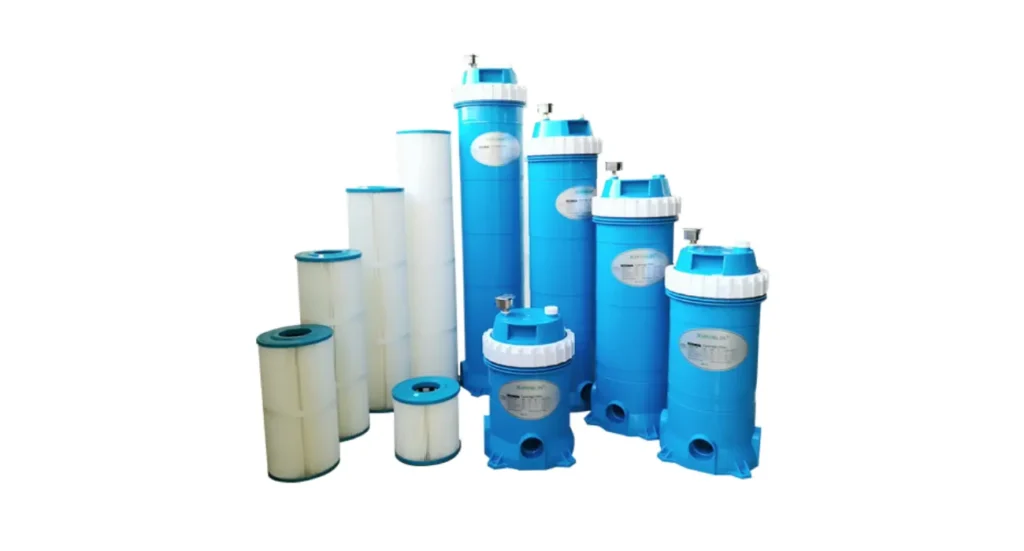
Cartridge filters are the perfectionists of the pool filter world. They use pleated filter cartridges made from polyester or paper-like materials to trap even tiny particles.
How they work: Water flows through pleated cartridge material with microscopic pores that trap particles as small as 10-15 microns – that’s incredibly fine filtration.
Pros:
- Superior filtration quality
- No backwashing required
- Water conservation (no water waste during cleaning)
- Compact size fits smaller equipment areas
- Lower pressure requirements
Cons:
- Regular cartridge replacement needed (every 2-4 months)
- Higher ongoing costs for replacement cartridges
- More hands-on maintenance (removing and cleaning cartridges)
Best for: Smaller to medium pools, environmentally conscious owners, areas with water restrictions.
DE Filters: The Ultimate in Filtration
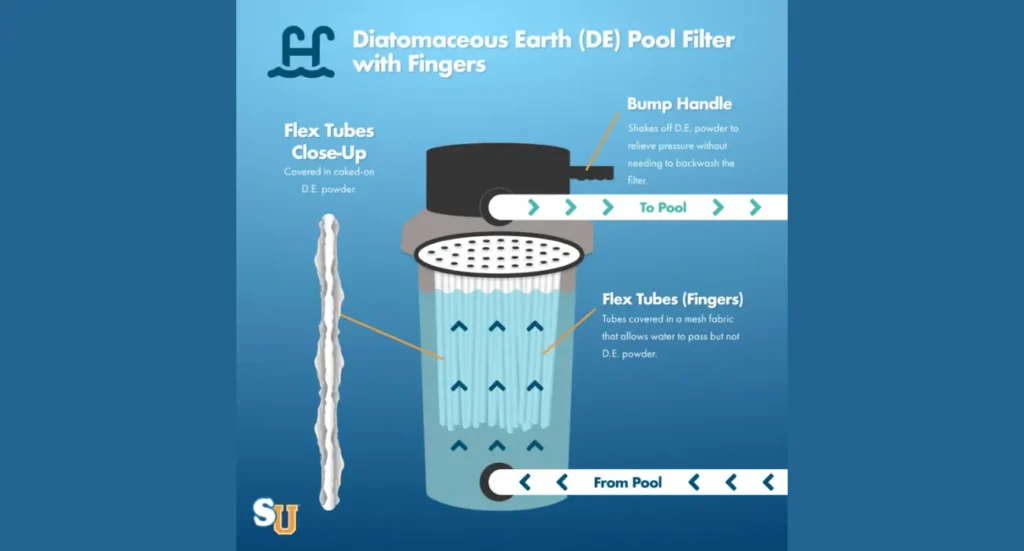
Diatomaceous Earth (DE) filters are the premium choice for pool owners who demand the absolute clearest water possible. They use fossilized diatoms (microscopic sea creatures) as the filtering medium.
How they work: DE powder coats internal grids, creating an incredibly fine filtering surface that traps particles as small as 3-5 microns.
Pros:
- Finest filtration available (hospital-grade quality)
- Crystal-clear water results
- Long filter grid life (grids last several years)
- Excellent for problem pools
Cons:
- Highest maintenance requirements
- DE powder handling safety considerations
- Most expensive initial cost and ongoing maintenance
- Complex backwashing and recharging process
Best for: Pool owners who want the absolute best water quality, commercial pools, problem pools with persistent clarity issues.
How Pool Filtration Systems Actually Work
Understanding how your pool pump and filter work together is crucial for effective maintenance and troubleshooting. Let me walk you through the complete process.
The Journey of Water Through Your System
Picture water as passengers on a circular train route that never stops:
- Intake Phase: Water enters through your pool’s skimmer (surface debris) and main drain (bottom debris)
- Pump Phase: Your pool pump creates suction, pulling water from the pool and pushing it toward the filter
- Filtration Phase: Water passes through your chosen filter medium, leaving contaminants behind
- Return Phase: Clean, filtered water flows back to your pool through return jets
- Circulation Phase: The process repeats continuously, typically 1-2 complete water turnovers daily
Pool Pump and Filter Partnership
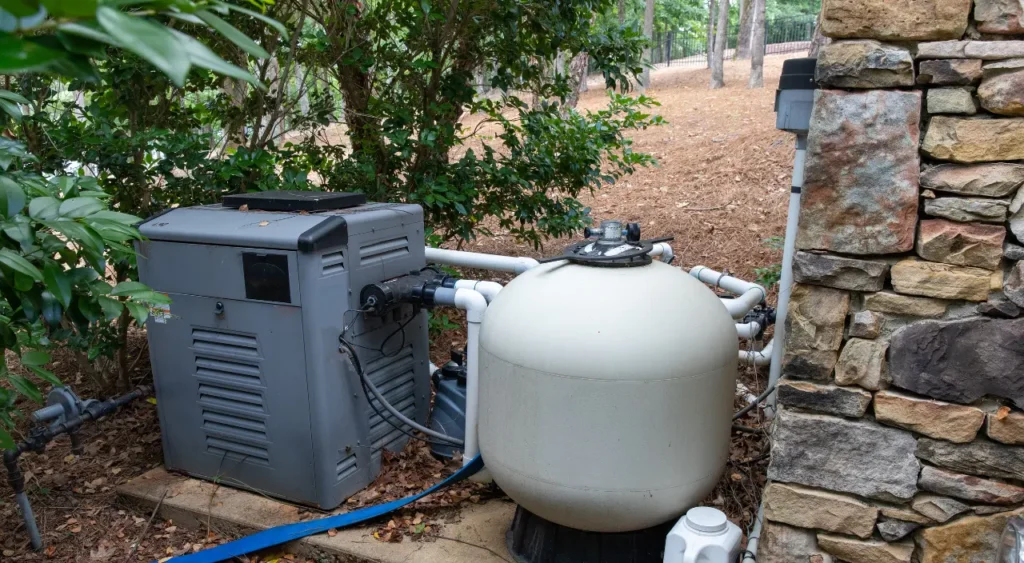
Your pump and filter are like dance partners – they must work in perfect harmony. The pump provides the power and circulation, while the filter provides the cleaning. Here’s what you need to know:
Pump Size Matters: Your pump must be properly sized for your filter. Too powerful, and you’ll damage the filter or create channeling (water finding easy paths through the filter medium). Too weak, and you won’t get proper filtration.
Flow Rate Balance: Most residential pools need 1-2 turnovers per day. Calculate your pool volume and ensure your pump can circulate that amount in 8-12 hours.
Pressure Monitoring: Your filter pressure gauge tells the story of your system’s health. Clean filters show lower pressure, while dirty filters show higher pressure.
Choosing the Right Pool Filter for Your Needs
Selecting the perfect pool filter isn’t just about price – it’s about matching the filter to your specific situation. Let me share the key factors that should guide your decision.
Pool Size and Bather Load Considerations
Pool Volume: Larger pools generally benefit from sand or DE filters due to their higher flow rates and larger debris-holding capacity. Smaller pools (under 20,000 gallons) often work perfectly with cartridge filters.
Bather Load: This is often overlooked but crucial. A pool that regularly hosts parties or has many daily swimmers needs more robust filtration than a pool used occasionally by a small family.
- Light use (1-4 people occasionally): Cartridge filters work excellently
- Moderate use (family of 4-6 daily): Sand filters provide reliability
- Heavy use (frequent entertaining, many swimmers): DE filters handle the load
Budget vs. Performance Trade-offs
Let’s be honest about costs because they add up over time:
Initial Investment:
- Sand filters: $200-$800
- Cartridge filters: $150-$500
- DE filters: $400-$1,200
Annual Operating Costs:
- Sand filters: $50-$100 (replacement sand every 3-5 years)
- Cartridge filters: $100-$300 (replacement cartridges)
- DE filters: $150-$400 (DE powder and occasional grid replacement)
Labor Costs: Consider your time as money. Sand filters require the least hands-on maintenance, while DE filters demand the most attention.
Climate and Usage Factors

Hot Climates: Higher temperatures accelerate algae growth and increase chemical consumption. DE filters excel in these conditions by providing superior clarity with fewer chemicals.
Windy Areas: Constant debris means your filter works harder. Sand filters handle large debris loads better than cartridge filters.
Water Quality: Hard water areas with high mineral content can quickly clog cartridge filters. Sand filters are more forgiving with poor source water.
Pool Filter Installation: Step-by-Step Process
Installing a pool filter might seem intimidating, but with proper preparation and safety measures, many pool owners can handle basic installations. However, knowing when to call professionals is equally important.
Tools and Preparation
Essential Tools:
- PVC pipe cutter or saw
- PVC primer and cement
- Teflon tape
- Adjustable wrenches
- Level
- Measuring tape
- Safety glasses and gloves
Pre-Installation Checklist:
- Turn off power to all pool equipment
- Drain water from existing plumbing lines
- Clear workspace around installation area
- Check local codes for any permit requirements
- Verify equipment compatibility with existing plumbing
Safety Considerations
Electrical Safety: Pool equipment involves electricity and water – a potentially deadly combination. Always turn off power at the breaker, not just the equipment switch. Use a multimeter to verify power is off.
Pressure Relief: Existing filters may have pressurized water. Release pressure slowly through the air relief valve before disconnecting plumbing.
Chemical Safety: If you’re replacing a DE filter, wear a dust mask when handling old DE powder. It’s a lung irritant.
Professional vs. DIY Installation
DIY-Friendly Scenarios:
- Replacing same-type filter (sand-to-sand, cartridge-to-cartridge)
- Minimal plumbing modifications needed
- Clear, accessible installation area
- Comfortable with basic plumbing tasks
Call a Professional When:
- Switching filter types (requires plumbing modifications)
- Electrical work needed
- Concrete cutting required
- Local codes require licensed installation
- You’re uncomfortable with any aspect of the job
Professional installation typically costs $200-$800 but includes warranty, permits, and peace of mind.
Pool Filter Maintenance: Keep It Running Smooth
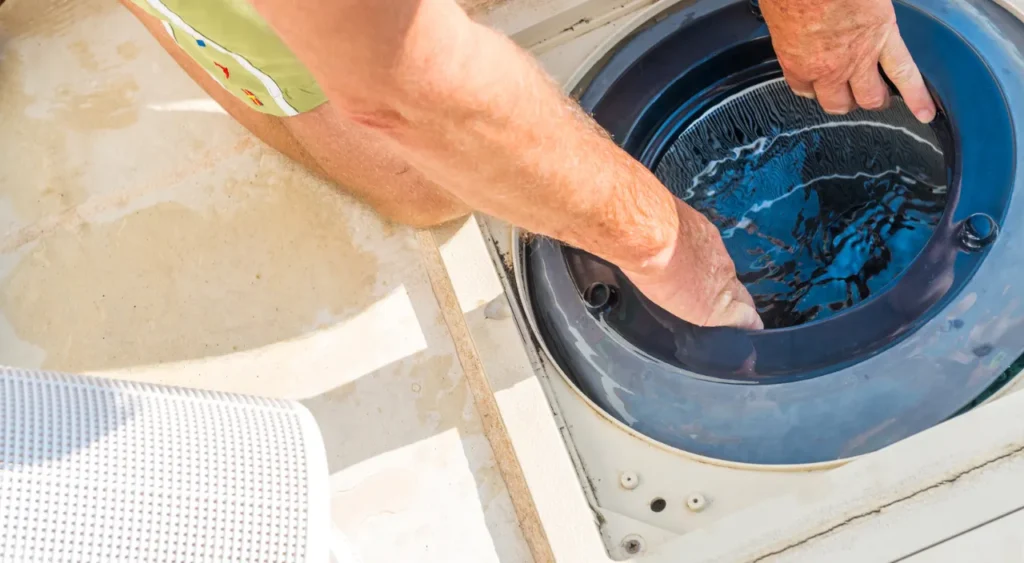
Proper pool filter maintenance is like changing the oil in your car – ignore it, and you’ll face expensive problems. Let me share the maintenance routines that keep your filter running efficiently for years.
Daily and Weekly Maintenance Tasks
Daily (2 minutes):
- Check pressure gauge – note the reading when filter is clean (baseline pressure)
- Empty skimmer baskets – prevents pump from running dry
- Quick visual inspection – look for leaks, unusual noises, or obvious problems
Weekly (15-20 minutes):
- Clean pump basket – remove debris that could damage your pump
- Check water level – low water causes pump to lose prime
- Monitor pressure increase – when pressure rises 8-10 PSI above baseline, it’s cleaning time
- Test water chemistry – proper chemical balance protects your filter
Seasonal Maintenance Requirements
Spring Startup:
- Deep clean filter regardless of type
- Inspect all seals and gaskets for winter damage
- Check plumbing connections for freeze damage
- Verify proper pump priming
Mid-Season (every 4-6 weeks):
- Thorough filter cleaning based on type
- Lubricate pump seals if accessible
- Check for wear patterns on filter media
Fall Winterization:
- Remove and store cartridges in freezing climates
- Drain filter tanks to prevent freeze damage
- Apply protective covers to equipment
Signs Your Filter Needs Attention
Immediate Action Required:
- Pressure gauge reading 8-10 PSI above baseline
- Decreased water flow from return jets
- Cloudy water despite proper chemical levels
- Visible debris passing through return jets
- Unusual noises from pump or filter
Weekly Monitoring:
- Gradual pressure increases over several days
- Slightly reduced circulation
- Minor water clarity issues
Filter Type-Specific Maintenance:
Sand Filters:
- Backwash weekly or when pressure rises
- Replace sand every 3-5 years
- Annual inspection of laterals and internal components
Cartridge Filters:
- Rinse cartridges weekly with garden hose
- Deep clean monthly with filter cleaner solution
- Rotate cartridge sets to extend life
- Replace cartridges every 2-4 months
DE Filters:
- Backwash and recharge when pressure rises
- Strip and clean grids monthly during season
- Replace grids every 2-3 years
- Annual inspection of internal manifold
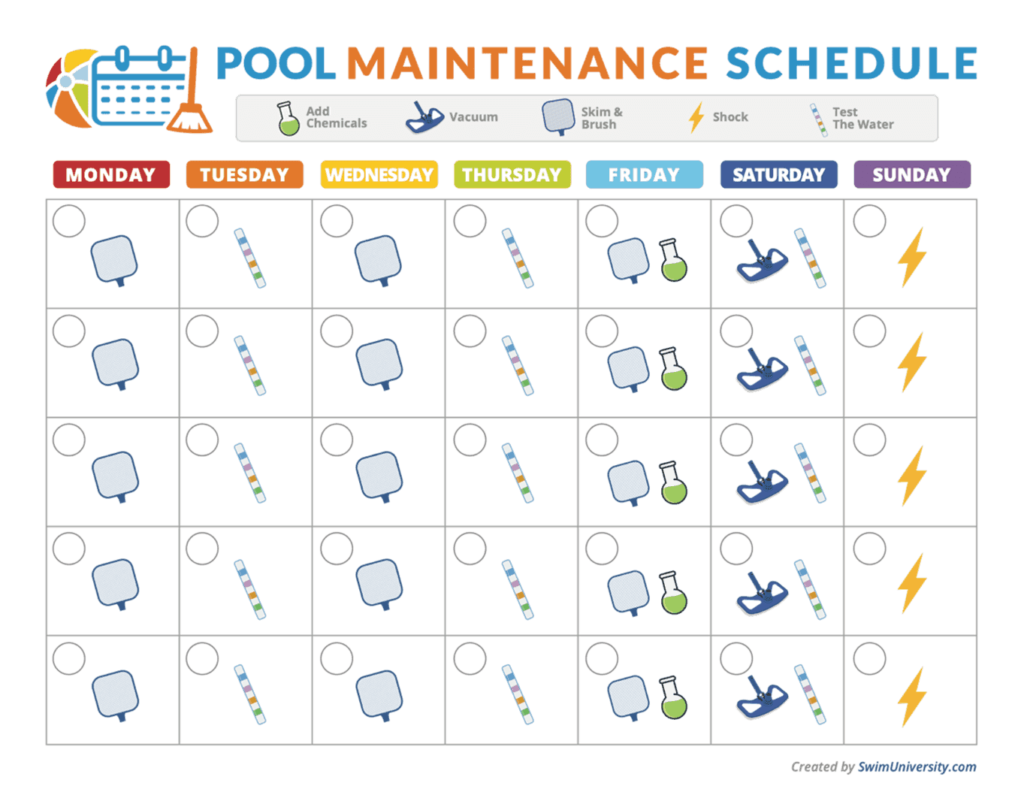
Troubleshooting Common Pool Filter Problems
Even with proper maintenance, pool filter problems can arise. Here’s how to diagnose and fix the most common issues before they become expensive headaches.
Poor Water Circulation Issues
Symptoms: Weak return jet flow, dead spots in pool, debris settling on pool bottom
Common Causes and Solutions:
Clogged Skimmer Basket:
- Quick Fix: Remove and clean basket
- Prevention: Empty baskets 2-3 times weekly during heavy debris seasons
Dirty Filter:
- Diagnosis: Pressure gauge 8+ PSI above baseline
- Solution: Clean or replace filter media according to type
- Prevention: Establish regular cleaning schedule
Air in System:
- Symptoms: Bubbles from return jets, pump loses prime
- Diagnosis: Check pump basket lid, skimmer throat, and plumbing joints
- Solution: Tighten loose connections, replace worn gaskets
Pump Problems:
- Symptoms: Unusual noises, overheating, frequent tripping
- Solution: Often requires professional diagnosis and repair
Cloudy Water Despite Filtration
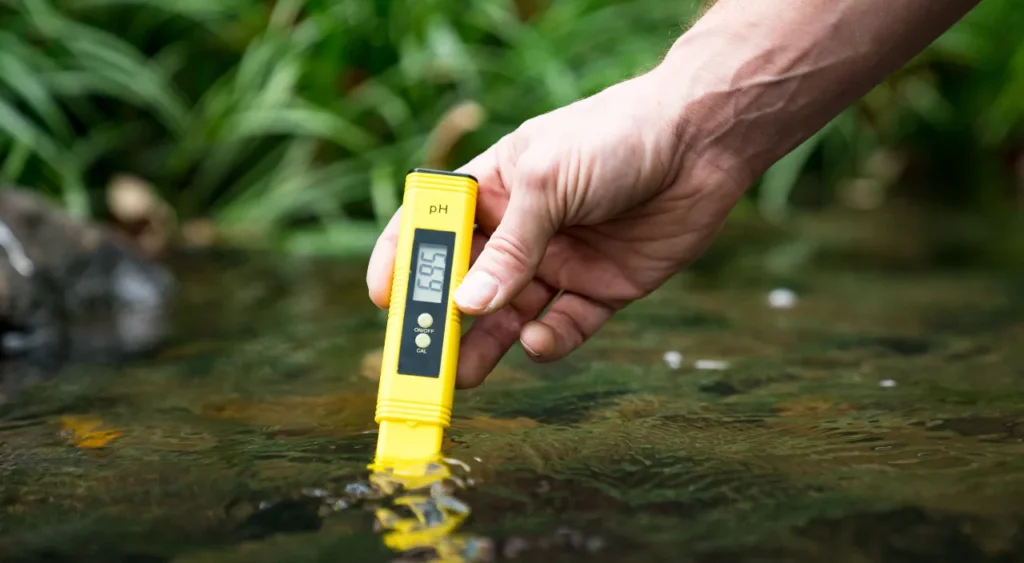
This is perhaps the most frustrating problem for pool owners. Let’s solve it systematically.
Chemical Imbalance:
- Test: pH, alkalinity, sanitizer levels
- Action: Balance water chemistry before assuming filter problems
- Common Issue: High pH reduces sanitizer effectiveness
Filter Bypassing:
- Cartridge Filters: Check for torn pleats or improper seating
- Sand Filters: Look for channeling or worn laterals
- DE Filters: Inspect grids for tears or missing DE powder
Inadequate Filtration Time:
- Standard: Run pump 1 hour per 10°F of air temperature
- Minimum: 8 hours daily, even in winter
- Heavy Use: May require 12+ hours daily
Filter Media Problems:
- Sand Filters: Old sand becomes rounded and less effective
- Cartridge Filters: Clogged pores can’t be cleaned
- DE Filters: Insufficient DE powder coating
Filter Pressure Problems
High Pressure (Above Normal + 8-10 PSI):
- Immediate Action: Clean filter media
- Persistent Issues: May indicate worn filter media or undersized filter
- Sand Filters: Backwash thoroughly, consider sand replacement
- Cartridge Filters: Deep clean with degreaser, replace if necessary
Low Pressure (Below Normal):
- Check: Pump basket, skimmer baskets, water level
- Possible Causes: Air leaks, pump problems, broken internal components
- Action: Start with basics (baskets, water level) before assuming equipment failure
Rapidly Fluctuating Pressure:
- Likely Cause: Air entering system
- Check: All plumbing connections, pump lid, skimmer throat
- Professional Help: May indicate underground plumbing leaks
When to Replace Your Pool Filter
Knowing when to replace your pool filter or its components can save you money and frustration. Here’s how to make informed replacement decisions.
Lifespan Expectations by Filter Type
Sand Filters:
- Filter Tank: 15-20 years with proper maintenance
- Sand Media: 3-5 years (sometimes longer with light use)
- Internal Components: Laterals and manifolds 5-10 years
- Warning Signs: Channeling, short time between backwashing, persistent cloudiness
Cartridge Filters:
- Filter Tank: 10-15 years
- Cartridge Elements: 2-4 months during season
- O-Rings and Seals: 2-3 years
- Warning Signs: Pleats won’t come clean, fabric deterioration, shortened cleaning cycles
DE Filters:
- Filter Tank: 15-20 years
- Filter Grids: 2-3 years with proper care
- Internal Manifold: 8-12 years
- Warning Signs: Grids with holes, fabric separation, bent frames
Warning Signs of Filter Failure
Immediate Replacement Needed:
- Cracked filter tank – safety hazard
- Broken internal components – compromises filtration
- Persistent bypass – contaminants returning to pool
- Excessive pressure even when clean
Plan Replacement Soon:
- Frequent cleaning required – filter media wearing out
- Declining water quality despite proper maintenance
- Visible wear on filter media or components
- Repair costs approaching replacement cost
Economic Considerations:
- Repair vs. Replace: If repair costs exceed 50% of replacement cost, replace
- Efficiency Loss: Older filters may use more energy and chemicals
- Warranty: New equipment comes with manufacturer warranties
Pro Tips for Maximum Filter Performance
After years of working with pool filtration systems, I’ve learned tricks that can dramatically improve performance and extend equipment life.
Optimize Your Pump Schedule:
- Variable Speed Pumps: Run at lower speeds for longer periods – saves energy and improves filtration
- Peak Efficiency: Most filters work best at moderate flow rates, not maximum
- Seasonal Adjustments: Increase runtime during hot weather and heavy use periods
Chemical Balance for Filter Health:
- Proper pH: Maintains filter media integrity and chemical effectiveness
- Adequate Sanitizer: Prevents biological growth in filter media
- Shock Treatments: Regular oxidation prevents organic buildup
Rotation Strategy for Cartridge Filters:
- Buy Extra Sets: Rotate between clean and dirty cartridges
- Thorough Drying: Let cartridges dry completely between uses
- Deep Cleaning: Monthly degreaser treatments extend cartridge life
Professional Maintenance:
- Annual Inspection: Professional eye can spot problems early
- Equipment Upgrades: Stay informed about efficiency improvements
- System Optimization: Professionals can fine-tune your entire system

Your Path to Crystal Clear Water
Your pool filter is more than just equipment – it’s the guardian of your family’s health and your pool’s beauty. Whether you choose the reliability of sand, the precision of cartridges, or the ultimate performance of DE filtration, proper selection, installation, and maintenance will reward you with years of crystal-clear water.
Remember, every pool is unique, and what works perfectly for your neighbor might not be ideal for your situation. Consider your budget, maintenance preferences, and performance expectations when making decisions. Don’t hesitate to consult with pool professionals when you’re unsure – their expertise can save you money and frustration in the long run.
The investment you make in understanding and maintaining your pool filter will pay dividends in reduced chemical costs, fewer water problems, and countless hours of enjoyment in your sparkling clean pool.
What’s your next step? Start by identifying which type of filter you currently have, then implement the appropriate maintenance schedule from this guide. Your pool – and your family – will thank you for it.
Ready to dive deeper into pool maintenance? Share your filter experiences in the comments below, or explore our complete pool care guide series for more expert tips and tricks.
FAQ’s
1. How do I figure out what size pool filter I need?
Another rule of thumb for pool filter size is to look at the swimming pool size in gallons. If you’ve never calculated this before, take some measurements. The formula is Length x Width x Average Depth x 7.5, for rectangular pools. For oval pools, change 7.5 to 5.9
2. Is it OK to oversize pool filter?
It is always advisable to buy large filters as they are easy to maintain and have better filtering capacity. They can filter even small particles and offer more time between cleaning and backwashing. Choosing the right filter size is overwhelming for many homeowners.
3. Is a bigger cartridge filter better?
With a large enough filter size, you can get away with checking your filter’s pressure gauge even once a month or more, as compared to getting a filter that’s sized “just right”. And as an added bonus, you also save water by lessening the need for backwash cycles or hosing down your filter cartridges.

